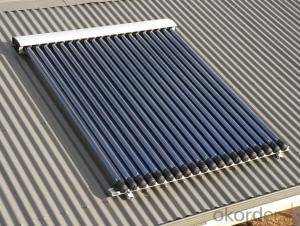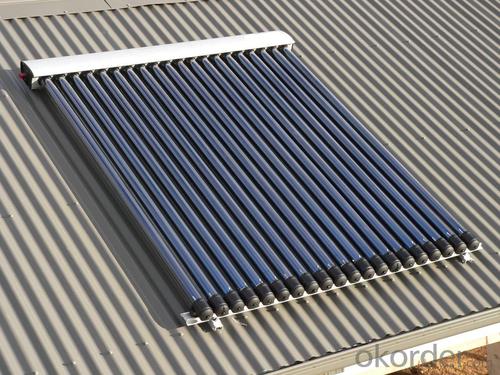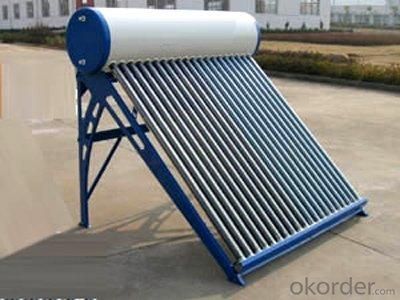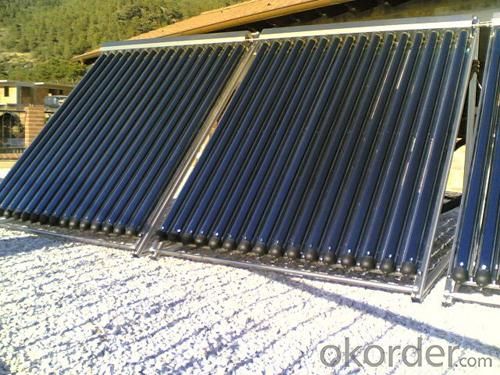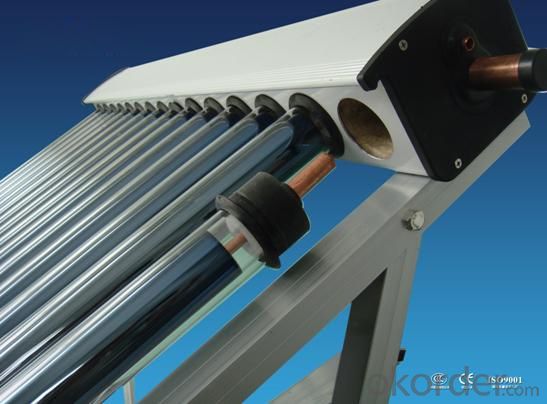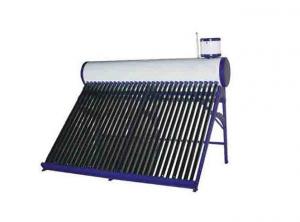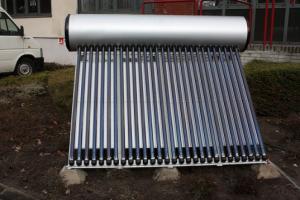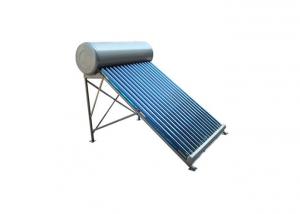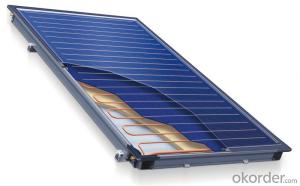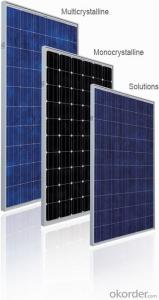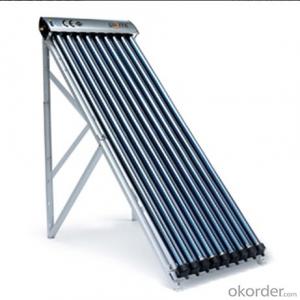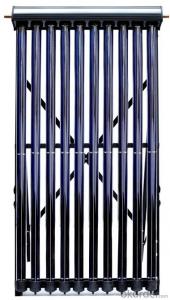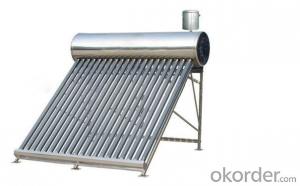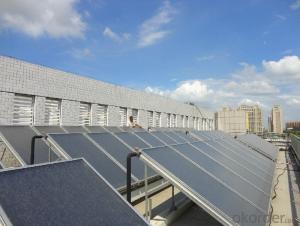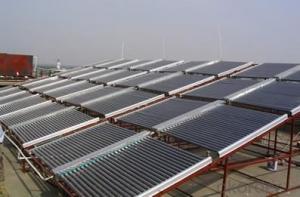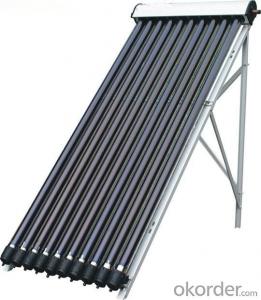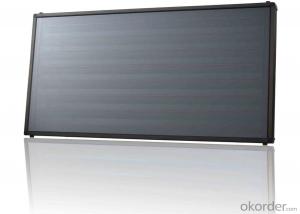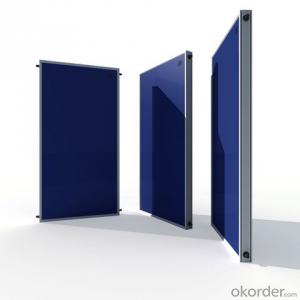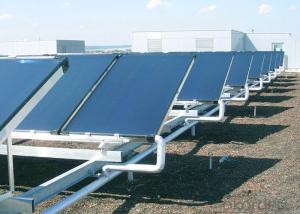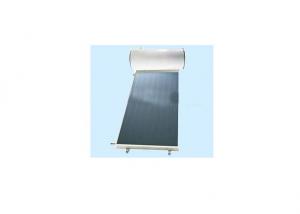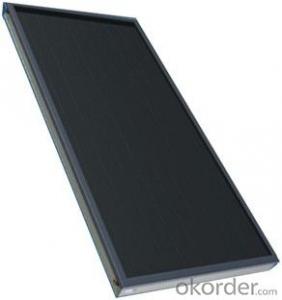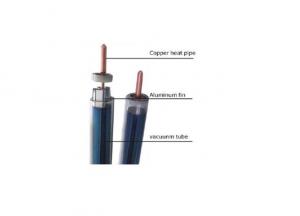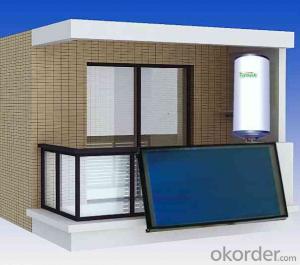Eagle Sun Solar Collectors - High Efficiency 2024 New Technology
- Loading Port:
- China main port
- Payment Terms:
- TT OR LC
- Min Order Qty:
- 5 set
- Supply Capability:
- 10000 set/month
OKorder Service Pledge
OKorder Financial Service
You Might Also Like
Specification
manifold (inner) | red copper |
manifold (exterior) | aluminum alloy |
glass tube dimensions | 58mm * 1800mm |
daily efficiency | ≥55% |
heat preservation | 72 hours |
hail resistance | 25mm |
max pressure | 7 bar |
coating of vacuum tube | ALN/AIN-SS/CU |
heat pipe | anti-freezing > -35 degree |
certificate | Solar Keymark, EN12975,SRCC |
Serious Product
Models | L*W*H mm | Vacuum tube | Power output | Efficiency | Header mm | Frame | container loading 20FT/40HQ sets | Gross Weight kg |
SHC-8 | 1917*910*133 | 58*1800*8pcs | 939W | 0.668 | Φ35/1.0 | AL alloy | 185/445 | 27 |
SHC-10 | 1917*1130*133 | 58*1800*10pcs | 1189W | 159/385 | 33 | |||
SHC-12 | 1917*1350*133 | 58*1800*12pcs | 1440W | 149/358 | 40 | |||
SHC-15 | 1917*1680*133 | 58*1800*15pcs | 1815W | 120/290 | 49 | |||
SHC-18 | 1917*2010*133 | 58*1800*18pcs | 2191W | 100/242 | 59 | |||
SHC-20 | 1917*2230*133 | 58*1800*20pcs | 2442W | 87/210 | 66 | |||
SHC-22 | 1917*2450*133 | 58*1800*22pcs | 2692W | 83/202 | 72 | |||
SHC-24 | 1917*2670*133 | 58*1800*24pcs | 2943W | 77/188 | 79 |
Packaging & Delivery
Packaging Details: | Exporting Carton with big foaming protection |
Delivery Detail: | In 10-15 days |
Loading Quantity
Model | Tube | Tube Q.T.Y | Loading Q.T.Y/40HQ |
GSC15 | 58*1800mm | 15pcs | 315sets |
GSC18 | 58*1800mm | 18pcs | 265sets |
GSC20 | 58*1800mm | 20pcs | 248sets |
GSC22 | 58*1800mm | 22pcs | 225sets |
GSC25 | 58*1800mm | 25pcs | 200sets |
GSC30 | 58*1800mm | 30pcs | 168sets |
Details of solar collector:

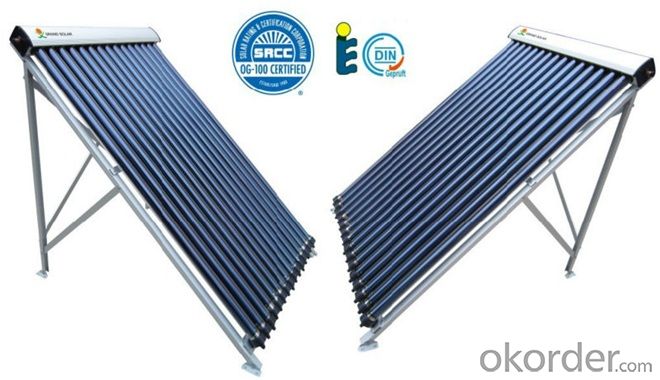
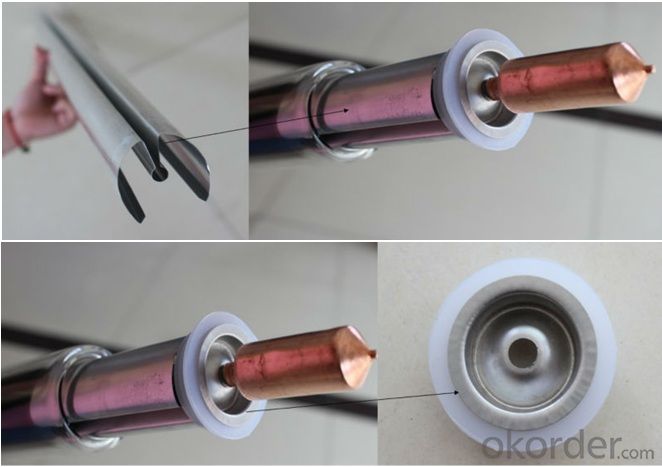
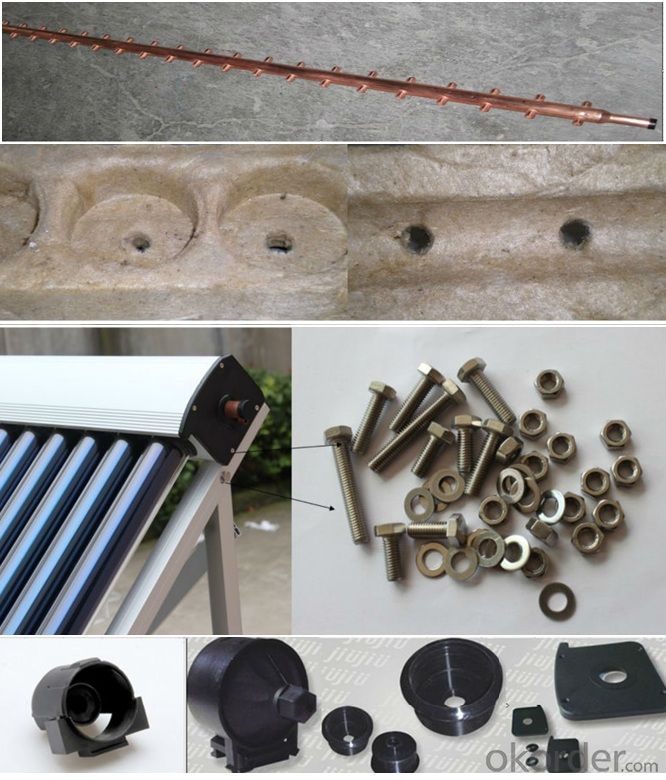
- Q: How do solar collectors perform in extreme weather conditions?
- Solar collectors are designed to withstand extreme weather conditions. They are built with durable materials that can resist harsh temperatures, strong winds, and heavy snowfall. Additionally, their design allows for self-cleaning and efficient heat transfer, ensuring optimal performance even in adverse weather conditions.
- Q: Can solar collectors be used for drying clothing and fashion accessories?
- Indeed, clothing and fashion accessories can be dried using solar collectors. These devices, also known as solar air heaters, are designed to capture sunlight and convert it into heat energy. This heat energy is then utilized to effectively and efficiently dry clothes and fashion accessories. Solar collectors consist of a black surface, typically made of metal or plastic, that absorbs sunlight and converts it into thermal energy. This energy is then transferred to air or water, which can be used for various purposes, including drying clothing and accessories. By utilizing solar collectors for drying clothes, one can take advantage of the abundant and free energy provided by the sun. This reduces the reliance on costly and carbon-emitting conventional energy sources like electricity or gas. Solar drying is particularly beneficial in areas with plenty of sunlight and warm temperatures. The process involves hanging clothes or accessories on a line or rack within the solar collector's vicinity. The absorbed sunlight heats up the air inside the collector, which then heats up the clothes, facilitating the drying process. Solar drying offers several advantages. Firstly, it is an environmentally friendly approach that relies on renewable energy, reducing the carbon footprint associated with traditional drying methods. Secondly, it can save money by reducing energy bills. Lastly, solar drying is especially beneficial for delicate fabrics or fashion accessories that may be sensitive to high temperatures or mechanical agitation in conventional drying methods. However, it is important to consider that the effectiveness of solar collectors for drying clothing and fashion accessories may vary depending on factors like weather conditions, location, and the specific items being dried. In areas with limited sunlight or cool temperatures, solar drying may not be as efficient or practical. In conclusion, solar collectors offer a sustainable and cost-effective alternative to conventional drying methods for clothing and fashion accessories.
- Q: What materials are used to make solar collectors?
- Solar collectors are typically made using materials such as glass, copper, aluminum, and various types of polymers.
- Q: Are there any safety concerns associated with solar collectors?
- Yes, there are a few safety concerns associated with solar collectors. One of the main concerns is the risk of fire. Due to the high temperatures and potential for overheating, proper installation and maintenance of solar collectors are necessary to prevent any fire hazards. Additionally, there is a risk of electrical shock during installation or maintenance if not done by trained professionals. Lastly, some solar collectors use potentially hazardous materials, such as lead or cadmium, which require proper handling and disposal to avoid environmental contamination. Overall, while solar collectors are generally safe, it is important to follow proper guidelines and precautions to mitigate any potential safety risks.
- Q: Can solar collectors be used in all climates?
- Solar collectors can be used in all climates, although their efficiency may vary depending on the amount of sunlight available in each climate.
- Q: Can solar collectors be used for heating in areas with high humidity?
- Solar collectors can indeed be utilized for heating purposes in regions with high humidity. Although the efficiency of solar collectors can be affected to some extent by high humidity, it does not render them completely ineffective. The functionality of solar collectors relies on the capture and conversion of the sun's energy into heat, which can then be employed for heating spaces or water. In areas with high humidity, the presence of moisture in the air can diminish the amount of direct sunlight that reaches the solar collectors. Consequently, this can lead to a slight reduction in efficiency compared to areas with lower humidity. However, even in environments with high humidity, solar collectors can still generate sufficient heat for heating purposes. Additionally, advancements in solar collector technology have resulted in the creation of more efficient and effective systems that are better equipped to handle humid conditions. For instance, certain solar collectors incorporate special coatings on their surfaces to minimize the impact of humidity on their performance. Furthermore, the utilization of heat exchangers and insulation in solar heating systems can further enhance their efficiency in areas with high humidity. It is crucial to note that while solar collectors can still be utilized for heating in regions with high humidity, it is imperative to appropriately design and size the system to account for the unique environmental conditions. This may entail selecting the suitable type of solar collector, optimizing its orientation and tilt, and considering factors such as shading and ventilation to maximize performance. Overall, although high humidity can slightly affect the efficiency of solar collectors, they can still be effectively employed for heating purposes in such areas with careful design considerations and technological advancements.
- Q: How does the size of a solar collector affect its performance?
- The size of a solar collector directly affects its performance. A larger collector will generally gather more sunlight and convert it into usable energy, resulting in higher performance and greater energy production. A larger surface area allows for more absorption of sunlight, leading to increased heat transfer and higher efficiency in converting solar energy to usable power. Additionally, a larger collector can capture sunlight from a wider range of angles, maximizing energy collection throughout the day.
- Q: Can solar collectors be used for heating wastewater treatment plants?
- Yes, solar collectors can be used for heating wastewater treatment plants. Solar thermal systems can provide a renewable and sustainable source of heat for various industrial processes, including wastewater treatment. By harnessing the sun's energy, solar collectors can heat water or other fluids, which can then be used to warm the wastewater in treatment plants. This can help reduce energy costs and carbon emissions associated with traditional heating methods.
- Q: Is solar collector directly using solar energy?
- Solar collectors are directly using solar energy. A solar collector is a device that converts radiant energy from the sun into heat.
- Q: Can solar collectors be used in remote areas without electricity?
- Without access to electricity, remote areas can utilize solar collectors to harness the ample solar energy present in these regions. These devices, also known as solar panels or photovoltaic (PV) systems, are designed to convert sunlight into electricity. They do not necessitate a direct connection to an electrical grid or power supply, making them perfect for areas where electricity infrastructure may be absent or unreliable. In these remote regions, solar collectors can be installed to capture the abundant solar energy available. The panels absorb sunlight and transform it into electrical energy, which can be used for various purposes such as powering lights, appliances, and even charging batteries. This offers a sustainable and eco-friendly solution to meet the energy requirements of the remote communities. Solar collectors are particularly advantageous in remote areas due to their low maintenance needs and long lifespan. Once installed, the panels require minimal upkeep, reducing the necessity for regular maintenance visits. Additionally, solar collectors are durable and have an average lifespan of 25-30 years, making them a dependable and long-term energy solution for remote areas. Furthermore, the implementation of solar collectors in remote areas can reduce reliance on fossil fuels, decrease greenhouse gas emissions, and contribute to climate change mitigation efforts. By substituting traditional energy sources like diesel generators or kerosene lamps with solar power, remote communities can lower their carbon footprint and enhance overall environmental conditions. Although initial installation costs may present challenges in some cases, the long-term benefits of utilizing solar collectors in remote areas without electricity far outweigh the disadvantages. Governments, non-profit organizations, and international agencies have acknowledged the importance of renewable energy in remote areas and have implemented various programs and initiatives to support the adoption of solar collectors in these regions. In conclusion, solar collectors can certainly be employed in remote areas without electricity. They offer a reliable and sustainable energy source, reduce dependence on fossil fuels, contribute to environmental preservation, and enhance the overall living standards of remote communities.
Send your message to us
Eagle Sun Solar Collectors - High Efficiency 2024 New Technology
- Loading Port:
- China main port
- Payment Terms:
- TT OR LC
- Min Order Qty:
- 5 set
- Supply Capability:
- 10000 set/month
OKorder Service Pledge
OKorder Financial Service
Similar products
Hot products
Hot Searches
Related keywords
